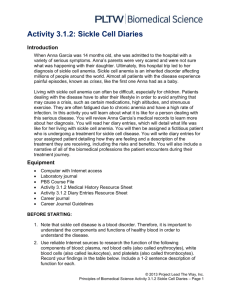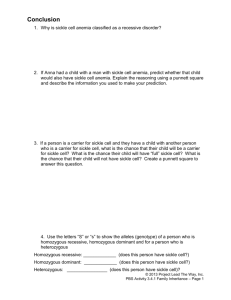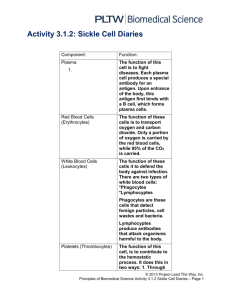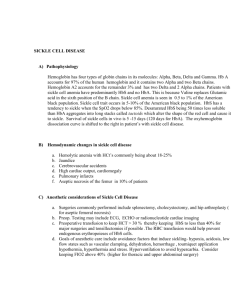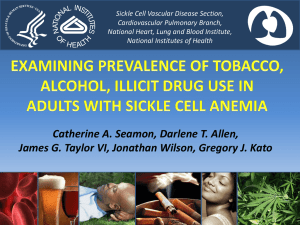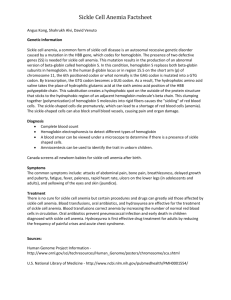File
advertisement
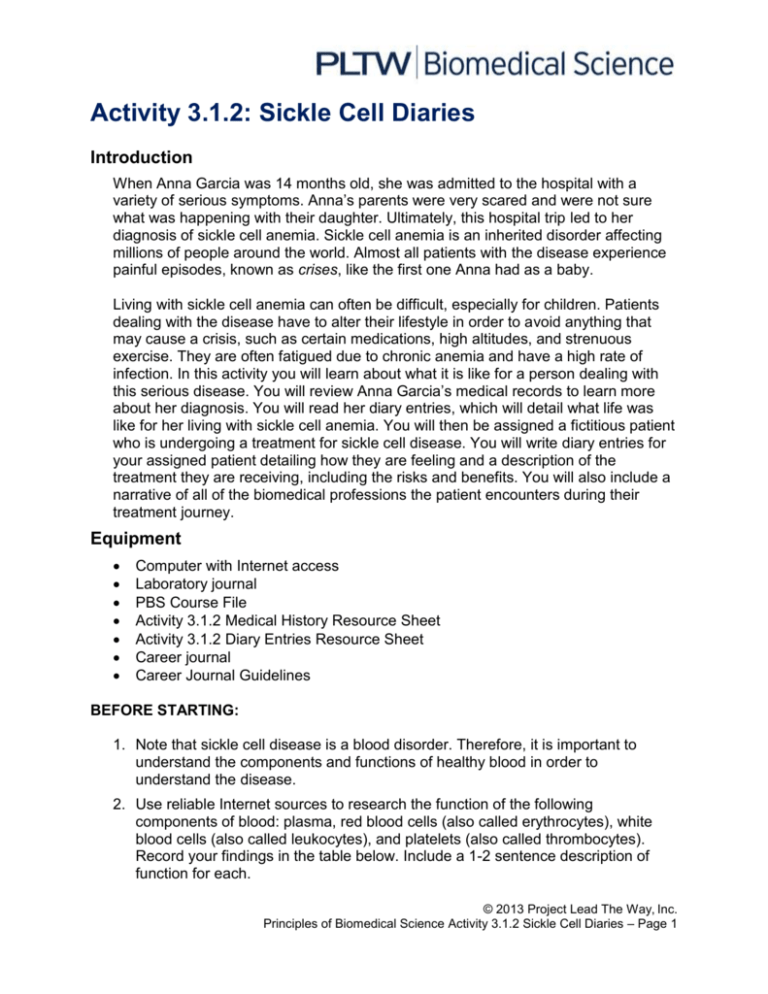
Activity 3.1.2: Sickle Cell Diaries Introduction When Anna Garcia was 14 months old, she was admitted to the hospital with a variety of serious symptoms. Anna’s parents were very scared and were not sure what was happening with their daughter. Ultimately, this hospital trip led to her diagnosis of sickle cell anemia. Sickle cell anemia is an inherited disorder affecting millions of people around the world. Almost all patients with the disease experience painful episodes, known as crises, like the first one Anna had as a baby. Living with sickle cell anemia can often be difficult, especially for children. Patients dealing with the disease have to alter their lifestyle in order to avoid anything that may cause a crisis, such as certain medications, high altitudes, and strenuous exercise. They are often fatigued due to chronic anemia and have a high rate of infection. In this activity you will learn about what it is like for a person dealing with this serious disease. You will review Anna Garcia’s medical records to learn more about her diagnosis. You will read her diary entries, which will detail what life was like for her living with sickle cell anemia. You will then be assigned a fictitious patient who is undergoing a treatment for sickle cell disease. You will write diary entries for your assigned patient detailing how they are feeling and a description of the treatment they are receiving, including the risks and benefits. You will also include a narrative of all of the biomedical professions the patient encounters during their treatment journey. Equipment Computer with Internet access Laboratory journal PBS Course File Activity 3.1.2 Medical History Resource Sheet Activity 3.1.2 Diary Entries Resource Sheet Career journal Career Journal Guidelines BEFORE STARTING: 1. Note that sickle cell disease is a blood disorder. Therefore, it is important to understand the components and functions of healthy blood in order to understand the disease. 2. Use reliable Internet sources to research the function of the following components of blood: plasma, red blood cells (also called erythrocytes), white blood cells (also called leukocytes), and platelets (also called thrombocytes). Record your findings in the table below. Include a 1-2 sentence description of function for each. © 2013 Project Lead The Way, Inc. Principles of Biomedical Science Activity 3.1.2 Sickle Cell Diaries – Page 1 Component: Function: Plasma Helps blood to clot, and transport substances through the blood Red Blood Cells (Erythrocytes) Transporting oxygen from the lungs to all of the body tissues. White Blood Cells (Leukocytes) Fight off infections Platelets (Thrombocytes) The prevention and control of bleeding. Find on the Internet images of a healthy red blood cell and sickle cell and copy and paste it below: Heathy blood cell Sickle cell Conclusion 1. You fall down and scrape your hand – describe what each component of blood would be doing at the injury site. First blood vessels leading to the wound tighten to reduce the flow of blood to the injured area. Platelets then rush to the scene, these sticky blood cells clump to each other and then adhere to the sides of the torn blood vessel, making a plug. Clotting proteins in the blood join forces to form a net that holds the platelet plug in place over the tear, and in just a few seconds or minutes, the bleeding stops. The fibrin plug becomes a scab that will eventually fall off or be reabsorbed into the body once healing is complete. © 2013 Project Lead The Way, Inc. Principles of Biomedical Science Activity 3.1.2 Sickle Cell Diaries – Page 2 2. Anna has a condition called sickle cell anemia, a blood disorder. Based on the differences you observed between the normal blood slide and Anna’s blood slide, what do you think is a defining feature of this disease? Explain your answer. The blood cells within the body start to take a cresent shape which can then cause the blood stream to clot. 3. How does the abnormal shape of a sickled red blood cell affect its movement through blood vessels? The sickle cells can cause a cot within the blood stream. 4. People with sickle cell anemia often experience episodes of severe pain in their joints, chest, and abdomen and swelling in their hands and feet. Using what you know about the function of blood, why do you think the abnormal shape of sickled red blood cells causes these symptoms? Because of the sickled cells shape they can restrict the amount of blood that is flowen through out the body, which can cause pain to certain limbs and joints. 5. Anna’s autopsy shows that the nails on her fingers were a blue/gray color. How does Anna’s hematocrit level relate to these symptoms? Due to the lack of haemoglobin in the blood, paleness with in the skin, lips, tongue, and fingernails are one of the symptoms of anaemia. 6. How might sickle cell disease have been related to Anna’s death? Because of sickle cell, anna could have been taking antibiotics, which would explain as to why there was a bottle of pills at the crime scene. Someone could have had anna overdose on antibiotics, which would explain the needle in her arm. © 2013 Project Lead The Way, Inc. Principles of Biomedical Science Activity 3.1.2 Sickle Cell Diaries – Page 3 Procedure 7. Obtain an Activity 3.1.2 Medical History Resource Sheet from your teacher. 8. Read through this piece of Anna’s medical history. 9. Answer Conclusion question 1. Almost every patient with sickle cell anemia experiences painful episodes called crises. These crises can last anywhere from a couple of hours to several days. The piece of Anna Garcia’s medical history that you just read is the documentation of Anna’s first sickle cell crisis. These crises vary from person to person. Some patients experience an episode only once every few years, while others experience many episodes per year. The crises can be severe enough to require a hospital stay. As part of Anna’s long term treatment plan, Anna’s doctor asked her to keep a diary documenting all of her crises. 10. Obtain a Activity 3.1.2 Diary Entries Resource Sheet from your teacher. 11. Make a graphic organizer that includes the following categories: symptoms, benefits associated with treatment, risks associated with treatment, biomedical professionals involved, and lifestyle concerns. 12. Read through the four diary entries and highlight or underline important information. As you read, take notes in the appropriate categories of your graphic organizer. 13. Answer Conclusion questions 2 and 3. 14. Add any new ideas to the Possible Causes of Death section on the Activity 3.1.1 Autopsy Report. 15. File the Activity 3.1.2 Medical History Resource Sheet and the Activity 3.1.2 Diary Entries Resource Sheet in the appropriate tabs of your course file. Use the PBS Course File – Table of Contents as a guide. 16. Note that your teacher will assign you one of the following sickle cell anemia patients: 4 year old male being treated with antibiotics and folic acid supplements 7 year old female being treated with chronic transfusion therapy 15 year old male who will have a bone marrow transplant 17. Write two journal entries from the perspective of your assigned patient or from the perspective of the patient’s parents. Include the following information in your journal entries: The symptoms the patient is experiencing and how this is affecting daily life. An explanation of what the treatment entails, including the risks and benefits A description of at least two of the biomedical professionals working with the patient. One of the biomedical professionals must be a hematologist. © 2013 Project Lead The Way, Inc. Principles of Biomedical Science Activity 3.1.2 Sickle Cell Diaries – Page 4 The description must detail the role the professionals played in the patient’s case. Note that you will complete career journal entries for these two professionals later in this activity. 18. Answer Conclusion question 4. 19. Collaborate with two classmates who were assigned other patients. Share your journal entries with these classmates. Create a graphic organizer similar to the one you created in Step 5 and take notes as they share their journal entries with you. 20. Follow the Career Journal Guidelines and complete two entries in your Career Journal for the two careers included in your patient journal entries. 21. Follow the PLTW Biomedical Science Documentation Protocol to correctly document or cite the sources of information you used. 22. Update the classroom evidence board with information from Lesson 3.1. 23. Answer the remaining Conclusion questions. Conclusion 24. Based on what you know about blood, why would having a sickle cell anemia crisis result in a reduced red blood cell count, an elevated white blood cell count, and a reduced hematocrit? 25. Based on what you learned in the previous activity, why did having sickled red blood cells lead to the symptoms documented in Anna’s medical history when she was 14 months old? Because of the sickled cells cloggintg the blood stram it can leave the body more open to infections. 26. Describe three ways daily life is affected for those who have sickle cell anemia. People with sickle cell can no longer go to the gym, they can no longer smoke, and are at a higher risk of catching a stroke. © 2013 Project Lead The Way, Inc. Principles of Biomedical Science Activity 3.1.2 Sickle Cell Diaries – Page 5 27. Describe at least five symptoms of a sickle cell crisis. Five symptoms of a sickle cell crisis is a fever, pain, weakness or fatigue and fast heartbeats. 28. Describe the pros and cons of the treatments used for each of the sickle cell anemia patients investigated in this activity. © 2013 Project Lead The Way, Inc. Principles of Biomedical Science Activity 3.1.2 Sickle Cell Diaries – Page 6

